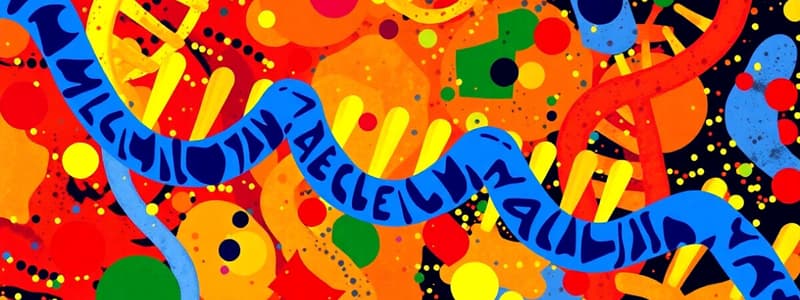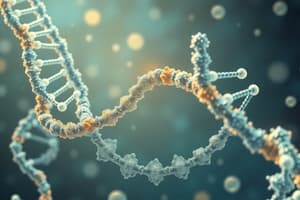Podcast
Questions and Answers
Which carbon atom of the sugar molecule does the phosphate group typically attach to in a nucleotide structure?
Which carbon atom of the sugar molecule does the phosphate group typically attach to in a nucleotide structure?
- C-1
- C-5 (correct)
- C-2
- C-3
Which of the following is an example of a pyrimidine nucleotide?
Which of the following is an example of a pyrimidine nucleotide?
- Cytidine monophosphate (CMP) (correct)
- Inosine monophosphate (IMP)
- Guanosine monophosphate (GMP)
- Adenosine monophosphate (AMP)
What is the significance of cAMP and cGMP in cellular function?
What is the significance of cAMP and cGMP in cellular function?
- They function as second messengers in hormone signaling (correct)
- They act as structural components of DNA
- They serve as primary energy storage molecules.
- They directly participate in protein synthesis.
In what metabolic process is UDP-glucose directly involved?
In what metabolic process is UDP-glucose directly involved?
Which conformer is most commonly found in nucleotides?
Which conformer is most commonly found in nucleotides?
What role does S-adenosyl methionine (SAM) play in cellular metabolism?
What role does S-adenosyl methionine (SAM) play in cellular metabolism?
What is a key function of purine nucleotides beyond their role in DNA and RNA structure?
What is a key function of purine nucleotides beyond their role in DNA and RNA structure?
How do ADP levels affect oxidative phosphorylation in mitochondria?
How do ADP levels affect oxidative phosphorylation in mitochondria?
Which of the following statements accurately describes the structural difference between purines and pyrimidines?
Which of the following statements accurately describes the structural difference between purines and pyrimidines?
Which of the following distinguishes a nucleotide from a nucleoside?
Which of the following distinguishes a nucleotide from a nucleoside?
Uracil is a pyrimidine base found in RNA. How does it differ structurally from thymine, a pyrimidine base found in DNA?
Uracil is a pyrimidine base found in RNA. How does it differ structurally from thymine, a pyrimidine base found in DNA?
A researcher identifies a modified nucleoside in a sample with a methyl group attached to the N7 position of guanine. Which of the following functional roles is this modification most likely to play?
A researcher identifies a modified nucleoside in a sample with a methyl group attached to the N7 position of guanine. Which of the following functional roles is this modification most likely to play?
A new drug is designed to interfere with the glycosidic bond formation in nucleotide synthesis. What specific interaction would this drug target?
A new drug is designed to interfere with the glycosidic bond formation in nucleotide synthesis. What specific interaction would this drug target?
Which of the following correctly pairs a nitrogenous base with its corresponding nucleoside when combined with ribose?
Which of the following correctly pairs a nitrogenous base with its corresponding nucleoside when combined with ribose?
How does the presence of methylated xanthines like caffeine, theophylline, and theobromine affect cellular processes, considering they are structurally similar to purines?
How does the presence of methylated xanthines like caffeine, theophylline, and theobromine affect cellular processes, considering they are structurally similar to purines?
A scientist is studying a novel virus and discovers it contains a modified pyrimidine base not typically found in terrestrial organisms. This base has a unique functional group attached at the 5' position. What is the most likely effect of this modification on the viral nucleic acid?
A scientist is studying a novel virus and discovers it contains a modified pyrimidine base not typically found in terrestrial organisms. This base has a unique functional group attached at the 5' position. What is the most likely effect of this modification on the viral nucleic acid?
Flashcards
Nucleotides
Nucleotides
Building units of nucleic acids; consist of a nitrogenous base, pentose sugar, and phosphate group.
DNA
DNA
Deoxyribonucleic acid: stores genetic information.
RNA
RNA
Ribonucleic acid: involved in protein synthesis.
Purines
Purines
Nitrogen-containing compounds with a double-ring structure; adenine and guanine.
Signup and view all the flashcards
Pyrimidines
Pyrimidines
Nitrogen-containing compounds with a single-ring structure; cytosine, thymine, and uracil.
Signup and view all the flashcards
Major Bases
Major Bases
Adenine, guanine, cytosine, thymine, and uracil.
Signup and view all the flashcards
Minor Bases
Minor Bases
Modified bases present in small amounts, often methylated; involved in regulation.
Signup and view all the flashcards
Nucleosides
Nucleosides
Base + sugar (ribose or deoxyribose)
Signup and view all the flashcards
What are nucleotides?
What are nucleotides?
The building blocks of nucleic acids (DNA and RNA), consisting of a base, a sugar, and a phosphate group.
Signup and view all the flashcards
Phosphate attachment point
Phosphate attachment point
The phosphate group is attached to the carbon at position 5 of the sugar molecule in a nucleotide.
Signup and view all the flashcards
What is tautomerism?
What is tautomerism?
The reversible interconversion of purines and pyrimidines between keto (lactam) and enol (lactim) forms, or amino and imino forms.
Signup and view all the flashcards
Common forms at pH
Common forms at pH
Purines and pyrimidines exist in two forms: keto (or lactam) or enol (lactim), and amino (-NH2) or imino (=NH). At physiological pH, the keto and amino forms are more common.
Signup and view all the flashcards
Syn and anti-conformers
Syn and anti-conformers
Nucleotides can exist in syn and anti conformations. The anti-conformer is the more stable and predominant form.
Signup and view all the flashcards
What is AMP?
What is AMP?
Adenosine monophosphate. A nucleotide composed of adenine base attached to a ribose sugar and a single phosphate group
Signup and view all the flashcards
Functions of purine nucleotides
Functions of purine nucleotides
Act as high-energy stores (ATP and GTP), intracellular signals (cAMP and cGMP), components of coenzymes (NAD, FAD, CoA), and regulatory molecules.
Signup and view all the flashcards
Functions of pyrimidine nucleotides
Functions of pyrimidine nucleotides
Enter in the structure of high energy intermediates (UDP-glucose), and act as high energy stores (CTP and UTP).
Signup and view all the flashcardsStudy Notes
Nucleotide Chemistry Overview
- Purine and pyrimidine bases along with their derivatives such as nucleosides and nucleotides are the components which make up nucleic acids.
- There are two main types of nucleic acids: Deoxyribonucleic acid (DNA) and Ribonucleic acid (RNA).
- The building block of nucleic acids is the nucleotide consisting of a nitrogenous base (purine or pyrimidine), a pentose sugar (ribose or deoxyribose), and a phosphate group.
Structural Breakdown
- Nucleotides are composed of a nucleoside and a phosphate group.
- Nucleosides are composed of a nitrogenous base (purine or pyrimidine) and a pentose sugar (ribose or deoxyribose).
Nitrogenous Bases
- Nitrogenous bases are heterocyclic ring compounds containing carbon and nitrogen atoms.
- There are two classes of nitrogenous bases based on their abundance in cells, which are major and minor bases.
Major Bases
- Present in large amounts:
- Purines include adenine and guanine, found in both DNA and RNA.
- Pyrimidines Include: Cytosine (present in both DNA and RNA), Thymine (present only in DNA), and Uracil (present only in RNA).
Minor Bases
- Present in trace amounts, often methylated, like 5-methyl cytosine and N7-methylguanine.
- Minor bases serve important functions such as oligonucleotide recognition, regulation of the half-life of RNAs, and protecting host DNA from digestion by DNAses.
- Xanthine, hypoxanthine, and uric acid exist as bases in a free state inside cells.
- Methylated xanthines include caffeine (1, 3, 7 trimethyl xanthine) in coffee, theophylline (1, 3 dimethyl xanthine) in tea, and theobromine (3, 7 dimethyl xanthine) in coca.
Nucleosides Details
- Nucleosides consist of a base and a sugar (either ribose or deoxyribose).
- Sugars bind bases via a covalent, β-N-glycosidic bond, linking the C₁ of the sugar with N-9 of a purine or N-1 of a pyrimidine.
- Numbering of the sugar atoms includes a prime symbol to differentiate sugar atoms from those of the base.
Nucleotides Details
- Nucleotides consist of a base, a sugar, and a phosphate group.
- The phosphate group is attached to the C-5 of the sugar.
Tautomerism
- Purines and pyrimidines can exist in two isoforms: keto (or lactam) or enol (lactim) form, and amino (-NH2) or imino (=NH) form.
- Tautomerism describes the change from one form to the other.
- The keto and amino forms are common at physiological pH.
Syn and Anti-Conformers
- Nucleotides exist as stable, non-interconvertible syn and anti-conformers.
- The β-N-glycosidic bond is a rigid bond with limited rotation, interconversion between conformers requires bond rupture and reformation.
- The anti-conformer is the predominant form.
Nomenclature of Bases, Nucleosides, and Nucleotides
- Adenine (A) becomes Adenosine as a nucleoside, and Adenosine monophosphate (AMP) as a nucleotide.
- Guanine (G) becomes Guanosine as a nucleoside, and Guanosine monophosphate (GMP) as a nucleotide.
- Xanthine (X) becomes Xanthosine as a nucleoside, and Xanthosine monophosphate (XMP) as a nucleotide.
- Hypoxanthine (I) becomes Inosine as a nucleoside, and Inosine monophosphate (IMP) as a nucleotide.
- Cytosine (C) becomes Cytidine as a nucleoside, and Cytidine monophosphate (CMP) as a nucleotide.
- Uracil (U) becomes Uridine as a nucleoside, and Uridine monophosphate (UMP) as a nucleotide.
- Thymine (T) becomes Thymidine as a nucleoside, and Thymidine monophosphate (TMP) as a nucleotide.
Functions of Nucleotides
- Both purine and pyrimidine nucleotides are essential for the structure of nucleic acids like DNA and RNA.
- Purine Nucleotides:
- Act as high-energy stores in the form of ATP and GTP.
- c-AMP and c-GMP function as second messengers for hormones.
- Integral to the structure of coenzymes such as NAD, NADP, FAD, and FMN, which serve as hydrogen carriers, and COASH, which acts as an acid carrier.
- Pyrimidine Nucleotides:
- Are part of high-energy intermediates like UDP-glucose, important in glycogenesis and the uronic acid pathway.
- Serve as high-energy stores in the form of CTP and UTP.
- Active in the structure of high energy intermediates: Uridine diphosphate glucose (UDP-glucose) used in glycogenesis and uronic acid pathway.
- Are active methyl donors, (S-adenosyl methionine, SAM).
- Are active sulfate donors, (3'phosphoadenosine-5'-phosphosulfate, PAPS).
- Serve regulatory functions: An example is ADP levels which regulate the rate of oxidative phosphorylation in mitochondria.
Studying That Suits You
Use AI to generate personalized quizzes and flashcards to suit your learning preferences.




